| Revision as of 20:50, 27 January 2013 view sourceSNAAAAKE!! (talk | contribs)Extended confirmed users96,243 editsNo edit summary← Previous edit | Revision as of 21:38, 27 January 2013 view source Unique2tell (talk | contribs)35 editsm Undid revision 535222655 by Niemti (talk) I have the right, as anyone else does to add informative facts to an article deemed to be historical fact. Niemti prefers to see history as Niemti sees it.Next edit → | ||
| Line 19: | Line 19: | ||
| }} | }} | ||
| {{plainlist | | {{plainlist | | ||
| ''']''' | ''']''' | ||
| * ] | * ] | ||
| }} | |||
| {{plainlist | | |||
| ''']''' | |||
| * ] | * ] | ||
| * ] | * ] | ||
Revision as of 21:38, 27 January 2013
This article is about the 1943 uprising in the Warsaw Ghetto. For other uprisings named in a similar manner, see Warsaw Uprising (disambiguation).
| Warsaw Ghetto Uprising | |||||||
|---|---|---|---|---|---|---|---|
| Part of World War II and the Holocaust | |||||||
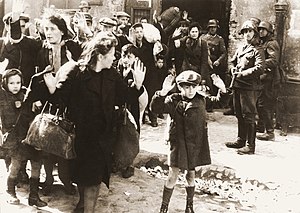 Photo from Jürgen Stroop's report to Heinrich Himmler from May 1943 and one of the best-known pictures of World War II. The original German caption reads: "Forcibly pulled out of dug-outs." | |||||||
| |||||||
| Belligerents | |||||||
| Volunteer Collaborators Subjugated Collaborators of "Nazi created Puppet Governments" |
| ||||||
| Commanders and leaders | |||||||
| |||||||
| Strength | |||||||
| Daily average of 2,090 including 821 Waffen-SS | About 600 ŻOB and about 400 ŻZW fighters, plus a number of Polish fighters | ||||||
| Casualties and losses | |||||||
| At least 17 killed, 93 wounded (German figures) | About 13,000 killed, 56,885 deported, mostly civilians (German estimate) | ||||||
| According to Stroop's unofficial account, 71,000 people in all were killed or deported. The 16 killed on the German side do not include Jewish forced collaborators. | |||||||
The Warsaw Ghetto Uprising (Template:Lang-yi; Template:Lang-pl; Template:Lang-de) was the 1943 act of Jewish resistance that arose within the Warsaw Ghetto in German-occupied Poland during World War II, and which opposed Nazi Germany's final effort to transport the remaining Ghetto population to Treblinka extermination camp. The most significant portion of the rebellion took place from 19 April, and ended when the poorly armed and supplied resistance was crushed by the Germans, who officially finished their operation to liquidate the Ghetto on 16 May. It was the largest single revolt by the Jews during World War II.
Background
Main articles: Warsaw Ghetto, Operation Reinhard, and Grossaktion Warsaw (1942)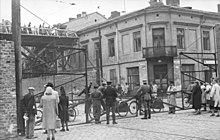
In 1940, German occupational authorities began to concentrate Poland's population of over three million Jews into a number of extremely crowded ghettos located in large Polish cities. The largest of these, the Warsaw Ghetto, concentrated approximately 300,000–400,000 people into a densely packed central area of Warsaw. Thousands of Jews died due to rampant disease and starvation under SS-and-Polizeiführer Odilo Globocnik and SS-Standartenführer Ludwig Hahn, even before the mass deportations from the Ghetto to the Treblinka extermination camp began.
The SS conducted many of the deportations during the operation code-named Grossaktion Warschau, between 23 July and 21 September 1942. Just before the operation began, the German "Resettlement Commissioner" SS-Sturmbannführer Hermann Höfle called a meeting of the Ghetto Jewish Council Judenrat and informed its leader, Adam Czerniaków, about the "resettlement to the East". Czerniaków committed suicide once he became aware of the true goal of the "resettlement" plan. Approximately 254,000–300,000 Ghetto residents met their deaths at Treblinka during the two-month-long operation. The Grossaktion was directed by SS-Oberführer Ferdinand von Sammern-Frankenegg, the SS and police commander of the Warsaw area since 1941. He was relieved of duty by SS-and-Polizeiführer Jürgen Stroop, sent to Warsaw by Heinrich Himmler on 17 April 1943. Stroop took over from von Sammern-Frankenegg following the failure of the latter to pacify the Ghetto resistance.
When the deportations first began, members of the Jewish resistance movement met and decided not to fight the SS directives, believing that the Jews were being sent to labour camps and not to their deaths. By the end of 1942, Ghetto inhabitants learned that the deportations were part of an extermination process. Many of the remaining Jews decided to revolt.
Opposing forces

Hanna Krall, who interviewed the only surviving uprising commander, Marek Edelman (from the left-wing Jewish Combat Organization, Żydowska Organizacja Bojowa, ŻOB), stated that the ŻOB had 220 fighters; and each was armed with a handgun, grenades, and Molotov cocktails. His organization had three rifles in each area, as well as two land mines and one submachine gun in the whole Ghetto. The insurgents had little ammunition; more weapons were supplied throughout the uprising, and some were captured from the Germans. Some weapons were hand-made by the resistance; sometimes such weapons worked, other times they jammed repeatedly.

Support from outside the Ghetto was limited, but Polish Resistance units from the mainstream Home Army (Armia Krajowa, AK) and the communist Polish Workers' Party's militia People's Guard (Gwardia Ludowa, GL) attacked German units near the Ghetto walls and attempted to smuggle weapons, ammunition, supplies, and instructions into the Ghetto. Polish resistance provided the insurgents with a limited number of badly needed weapons and ammunitions from its meager stocks. Jewish right-wing resistance in the Jewish Military Union (Żydowski Związek Wojskowy, ŻZW) received large quantities of armament, including several automatic weapons, from the AK-affiliated National Security Corps (Państwowy Korpus Bezpieczeństwa, PKB). AK disseminated information and appeals to help the Jews in the Ghetto, both in Poland and by way of radio transmissions to the Allies. Several ŻOB commanders and fighters later escaped through the sewers with assistance from the Poles and joined Polish underground. A PKB unit commanded by Henryk Iwański ("Bystry") even fought inside the Ghetto along with ŻZW and subsequently both groups retreated together (including 34 Jewish fighters) to the so-called Aryan side. Although Iwański's action is the most well-known rescue mission, it was only one of many actions undertaken by the Polish resistance to help the Jewish fighters.
Participation of the Polish underground in the uprising was confirmed by a report of the German commander Jürgen Stroop, who wrote:
"When we invaded the Ghetto for the first time, the Jews and the Polish bandits succeeded in repelling the participating units, including tanks and armored cars, by a well-prepared concentration of fire. ... The main Jewish battle group, mixed with Polish bandits, had already retired during the first and second day to the so-called Muranowski Square. There, it was reinforced by a considerable number of Polish bandits. Its plan was to hold the Ghetto by every means in order to prevent us from invading it. ... Time and again Polish bandits found refuge in the Ghetto and remained there undisturbed, since we had no forces at our disposal to comb out this maze. ... One such battle group succeeded in mounting a truck by ascending from a sewer in the so-called Prosta , and in escaping with it (about 30 to 35 bandits). ... The bandits and Jews – there were Polish bandits among these gangs armed with carbines, small arms, and in one case a light machine gun – mounted the truck and drove away in an unknown direction."
— Jürgen Stroop, 1943
On the other hand, despite German evidence of Polish fighters joining the struggle, some survivors have reported different experiences. In her book On Both Sides of the Wall, Vladka Meed, who was a member of the Warsaw Ghetto underground, devoted a chapter to the lack of support from the Polish resistance, writing, "We knew that the Polish underground had secret caches of weapons. Mikolai was in touch with the leaders of the Polish underground, ‘They keep making promises!’ he told me again and again. We are urged to be patient. (...) Often, we wondered why, in spite of our willingness to pay generously, the underground refused to help us. However, our contacts with the Poles were tenuous and often came to grief; many times we were sold out."

Ultimately, the efforts of the Jewish resistance fighters proved insufficient against the German occupation system. According to Hanna Krall, the German task force dispatched to put down the revolt and complete the deportation action numbered 2,090 men armed with artillery pieces, armored vehicles, minethrowers, 82 machine guns and 135 submachine guns. Its backbone consisted of 821 Waffen-SS Panzergrenadier troops in five SS reserve and training battalions and one SS cavalry reserve and training battalion. The other forces were drawn from the Ordnungspolizei (Orpo) order police (battalions from the 22rd and 23rd regiments), the Sicherheitsdienst (SD) security service of the SS, the Warsaw Gestapo, one battalion each from two Wehrmacht (Heer) railroad combat engineers regiments, a battery of Wehrmacht anti-aircraft artillery pieces and one field gun, a battalion of ex-Soviet POW "Trawniki-Männer" trainees from the concentration camp Trawniki, detachments from Latvian Auxiliary Police and Lithuanian Auxiliary Police which were subjugated by the Nazi regime that had occupied their nations, and technical emergency corps. Some personnel from the nearby Gestapo Pawiak prison, led by Franz Bürkl, volunteered to join. 363 officers from the Polish Police of the General Government (so-called Blue Police) were ordered by the Germans to cordon the walls of the Ghetto. Warsaw fire department personnel were also forced to help in the operation. Jewish policemen were used in the first phase of the Ghetto's liquidation and subsequently summarily executed by the Gestapo.
January to April 1943
On 18 January 1943, the Germans began their second deportation of the Jews, which led to the first instance of armed insurgency within the Ghetto. While Jewish families hid in their so-called "bunkers", fighters of the ŻZW, joined by elements of the ŻOB, resisted, engaging the Germans in direct clashes. Though the ŻZW and ŻOB suffered heavy losses (including some of their leaders), the Germans also took casualties, and the deportation was halted within a few days. Only 5,000 Jews were removed, instead of the 8,000 planned by Globocnik. Hundreds of people in the Warsaw ghetto were ready to fight, adults and children, sparsely armed with handguns, gasoline bottles, and a few other weapons that had been smuggled into the Ghetto by resistance fighters.
Two resistance organizations, the ŻZW and ŻOB, took control of the Ghetto. They built dozens of fighting posts and executed a number of Nazi collaborators, including Jewish Police officers, members of the fake (German-sponsored and controlled) resistance organization Żagiew, as well as Gestapo agents (such as Judenrat member Dr Alfred Nossig, executed on 22 February 1943). The ŻOB established a prison to hold and execute traitors and collaborators. Józef Szeryński, former head of the Jewish Ghetto Police, committed suicide.
April to May 1943

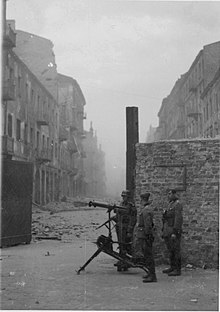
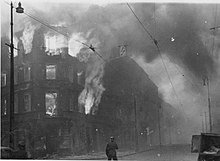
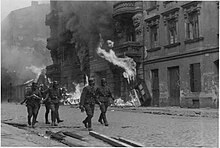

On 19 April 1943, on the eve of Passover, the police and SS auxiliary forces entered the Ghetto. They were planning to complete the deportation action within three days, but were ambushed by Jewish insurgents firing and tossing Molotov cocktails and hand grenades from alleyways, sewers, and windows. The Germans suffered casualties and their advance bogged down. Two of their combat vehicles (an armed conversion of a French-made Lorraine 37L light armored vehicle and an armored car) were set on fire by insurgent petrol bombs. Following von Sammern-Frankenegg's failure to contain the revolt, he lost his post as the SS and police commander of Warsaw. He was replaced by SS-Brigadeführer Jürgen Stroop, who rejected von Sammern-Frankenegg's proposal to call in bomber aircraft from Kraków and proceeded to lead a better-organized and reinforced ground attack.
The longest-lasting defense of a position took place around the ŻZW stronghold at Muranowski Square, where the ŻZW chief leader, Dawid Moryc Apfelbaum, was killed in combat. On the afternoon of 19 April, a symbolic event took place when two boys climbed up on the roof of a building on the square and raised two flags, the red-and-white Polish flag and the blue-and-white banner of the ŻZW (and the colours of the flag of Israel today). These flags remained there, highly visible from the Warsaw streets, for four days. After the war, Stroop recalled:
"The matter of the flags was of great political and moral importance. It reminded hundreds of thousands of the Polish cause, it excited them and unified the population of the General Government, but especially Jews and Poles. Flags and national colours are a means of combat exactly like a rapid-fire weapon, like thousands of such weapons. We all knew that – Heinrich Himmler, Krüger, and Hahn. The Reichsfuehrer bellowed into the phone: 'Stroop, you must at all costs bring down those two flags!'"
— Jürgen Stroop, 1949
When Stroop's ultimatum to surrender was rejected by the defenders, his forces resorted to systematically burning houses block by block using flamethrowers and fire bottles, and blowing up basements and sewers. "We were beaten by the flames, not the Germans," Edelman said in 2007. In 2003, he recalled: "The sea of flames flooded houses and courtyards. ... There was no air, only black, choking smoke and heavy burning heat radiating from the red-hot walls, from the glowing stone stairs."
While the battle continued inside the Ghetto, Polish resistance groups AK and GL engaged the Germans between 19 and 23 April at six different locations outside the Ghetto walls, firing at German sentries and positions. In one attack, three units of the AK under the command of Captain Józef Pszenny ("Chwacki") joined up in a failed attempt to breach the Ghetto walls with explosives. Eventually, the ŻZW lost all of its commanders and, on 29 April, the remaining fighters from the organization escaped the Ghetto through the Muranowski tunnel and relocated to the Michalin forest. This event marked the end of significant fighting.
At this point, organized defense collapsed. Surviving fighters and thousands of remaining Jewish civilians took cover in the sewer system and in the many dugout hiding places hidden among the ruins of the Ghetto, referred to as "bunkers" by Germans and Jews alike. The Germans used dogs to look for such hideouts, then usually dropped smoke bombs down to force people out. Sometimes they flooded these so-called bunkers or destroyed them with explosives. On occasions, shootouts occurred. A number of captured fighters—especially the women—lobbed hidden grenades or fired concealed handguns after surrendering. There were also clashes between small groups of insurgents and German patrols at night.
On May 8, the Germans discovered a large dugout located at Miła 18 Street, which served as ŻOB's main command post. Most of the organization's remaining leadership and dozens of others committed a mass suicide by ingesting cyanide. They included the chief commander of ŻOB, Mordechaj Anielewicz. His deputy Marek Edelman escaped the Ghetto through the sewers with a handful of comrades two days later.
On May 10, a Bundist member of the Polish government in exile, Szmul Zygielbojm, committed suicide in London to protest the lack of reaction from the Allied governments. In his farewell note, he wrote:
"I cannot continue to live and to be silent while the remnants of Polish Jewry, whose representative I am, are being murdered. My comrades in the Warsaw ghetto fell with arms in their hands in the last heroic battle. I was not permitted to fall like them, together with them, but I belong with them, to their mass grave. By my death, I wish to give expression to my most profound protest against the inaction in which the world watches and permits the destruction of the Jewish people."
The suppression of the uprising officially ended on 16 May 1943, when Stroop personally pushed a detonator button to demolish the Great Synagogue of Warsaw. Sporadic resistance continued and the last skirmish took place on 5 June 1943 between Germans and a holdout group of armed Jews without connections to the resistance organizations.
Death toll

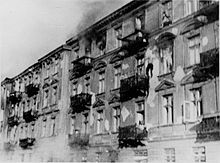
13,000 Jews were killed in the ghetto during the uprising (some 6,000 among them were burnt alive or died from smoke inhalation). Of the remaining 50,000 residents, most were captured and shipped to concentration and extermination camps, in particular to Treblinka.
Jürgen Stroop's internal SS daily report for Friedrich Krüger, written on 16 May 1943, stated:
"180 Jews, bandits and sub-humans, were destroyed. The former Jewish quarter of Warsaw is no longer in existence. The large-scale action was terminated at 20:15 hours by blowing up the Warsaw Synagogue. ... Total number of Jews dealt with 56,065, including both Jews caught and Jews whose extermination can be proved. ... Apart from 8 buildings (police barracks, hospital, and accommodations for housing working-parties) the former Ghetto is completely destroyed. Only the dividing walls are left standing where no explosions were carried out."
According to the casualty lists in Stroop's report, German forces suffered 16 killed in action and 85 wounded in action listed by name, including over 60 members of the Waffen-SS. These figures did not include Jewish collaborators, but included non-German troops under his command. The real number of German losses, however, may be well higher (the Germans suffered about 300 casualties by Edelman's estimate). For propaganda purposes, the official announcement claimed the German casualties to be only a few wounded, while propaganda bulletins of the Polish Underground State announced that hundreds of occupiers had been killed in the fighting.
German daily losses and the official figures for killed or captured Jews and "bandits", according to the Stroop report:
Stroop report's figures by day- 19 April: 1 killed, 24 wounded; 580 captured
- 20 April: 3 killed, 10 wounded; 533 captured
- 21 April: 0 killed, 5 wounded; 5,200 captured
- 22 April: 3 killed, 1 wounded; 6,580 captured; 203 "Jews and bandits" killed; 35 Poles killed outside the Ghetto
- 23 April: 0 killed, 3 wounded; 4,100 captured; 200 "Jews and bandits" killed; 3 Jews captured outside the Ghetto.Total of 19,450 Jews reported caught
- 24 April: 0 killed, 3 wounded; 1,660 captured; 1,811 "pulled out of dugouts, about 330 shot."
- 25 April: 0 killed, 4 wounded; 1,690 captured; 274 shot; "very large portion of the bandits...captured". Total of 27,464 Jews caught
- 26 April: 0 killed, 0 wounded; 1,722 captured; 1,330 "destroyed"; 362 Jews shot. 30 Jews "displaced". Total of 29,186 Jews captured
- 27 April: 0 killed, 4 wounded; 2,560 captured of whom 547 shot; 24 Polish "bandits killed in battle"; 52 Polish "bandits" arrested. Total of 31,746 Jews caught
- 28 April: 0 killed, 3 wounded; 1,655 captured of whom 110 killed; 10 "bandits" killed and 9 "arrested". Total of 33,401 Jews caught
- 29 April: 0 killed 0 wounded; 2,359 captured of whom 106 killed
- 30 April: 0 killed 0 wounded; 1,599 captured of whom 179 killed. Total of 37,359 Jews caught
- 1 May: 2 killed, 2 wounded; 1,026 captured of whom 245 killed. Total of 38,385 Jews caught; 150 killed outside the Ghetto
- 2 May: 0 killed, 7 wounded; 1,852 captured and 235 killed. Total of 40,237 Jews caught
- 3 May: 0 killed, 3 wounded; 1,569 captured and 95 killed. Total of 41,806 Jews caught
- 4 May: 0 killed, 0 wounded; 2,238 captured, of whom 204 shot. Total of 44,089 Jews caught
- 5 May: 0 killed, 2 wounded; 2,250 captured
- 6 May: 2 killed, 1 wounded; 1,553 captured; 356 shot
- 7 May: 0 killed, 1 wounded; 1,109 captured; 255 shot. Total of 45,342 Jews caught
- 8 May: 3 killed, 3 wounded; 1,091 captured and 280 killed; 60 "heavily armed bandits" caught
- 9 May: 0 killed, 0 wounded; 1,037 "Jews and bandits" caught and 319 "bandits and Jews" shot. Total of 51,313 Jews caught; 254 "Jews and bandits" shot outside the Ghetto
- 10 May: 0 killed, 4 wounded; 1,183 caught and 187 "bandits and Jews" shot. Total of 52,693 Jews caught
- 11 May: 1 killed, 2 wounded; 931 "Jews and bandits" caught and 53 "bandits" shot. Total of 53,667 Jews caught
- 12 May: 0 killed, 1 wounded; 663 caught and 133 shot. Total of 54,463 Jews caught
- 13 May: 2 killed, 4 wounded; 561 caught and 155 shot. Total of 55,179 Jews caught
- 14 May: 0 killed, 5 wounded; 398 caught and 154 "Jews and bandits" shot. Total of 55,731 Jews caught
- 15 May: 0 killed, 1 wounded; 87 caught and 67 "bandits and Jews" shot. Total of 56,885 Jews caught
- 16 May: 0 killed, 0 wounded; 180 "Jews, bandits and subhumans destroyed". Total of 57,065 Jews either captured or killed
According to Israel Gutman, "the number cited by Stroop (16 dead, 85 wounded) cannot be rejected out of hand, but it is likely that his list was neither complete, free of errors, nor indicative of the German losses throughout the entire period of resistance, until the absolute liquidation of Jewish life in the ghetto. All the same, the German casualty figures cited by the various Jewish sources are probably highly exaggerated." Other historians such as Raul Hilberg and French L. MacLean endorse the accuracy of official German casualty figures. On the other hand, Stroop report vastly exaggerated actual losses (and strength) of the resistance.
Aftermath
See also: Warsaw Uprising

After the uprising, most of the incinerated houses were razed, and the Warsaw concentration camp complex was established in their place. Thousands of people died in the camp or were executed in the ruins of the Ghetto. At the same time, the SS were hunting down the remaining Jews still hiding in the ruins. On 19 April 1943, the first day of the most significant period of the resistance, 7,000 Jews were transported from the Warsaw Ghetto to Treblinka extermination camp, where, purportedly, they developed again into resistance groups, and then helped to plan and execute the revolt and mass escape of 2 August 1943.
In October 1943, Bürkl was tried and condemned to death in absentia by the Polish Resistance's Special Courts, and shot dead by the AK in Warsaw, a part of Operation Heads targeting notorious SS officers. That same month, von Sammern-Frankenegg was killed by Yugoslav Partisans in an ambush in Croatia. Himmler, Globocnik and Krüger all committed suicide at the of the war in Europe in May 1945. Stroop was convicted of war crimes in two different trials (U.S. military and Polish) and executed by hanging in Poland in 1952. His aide, Erich Steidtmann, was exonerated for "minimal involvement"; he died in 2010 while under investigation for war crimes. Hahn went into hiding until 1975, when he was apprehended and sentenced to life for crimes against humanity; he died in prison in 1986.
The Warsaw Ghetto Uprising of 1943 took place over a year before the Warsaw Uprising of 1944. The Ghetto had been totally destroyed by the time of the general uprising in the city, which was part of the Operation Tempest, a nationwide insurrection plan. During the Warsaw Uprising, the AK's Battalion Zośka was able to rescue 380 Jewish prisoners held in a concentration camp "Gęsiówka" set up by the Germans in the area adjacent to the ruins of former Ghetto. A few small groups of Ghetto residents also managed to survive in the underground sewer system. In all, several hundred survivors from the first uprising took part in the later uprising (mostly in non-combat roles such as logistics and maintenance, due to their physical state and general shortage of arms), joining the ranks of the AK and the AL. According to Samuel Krakowski from the Jewish Historical Institute, "The Warsaw Ghetto Uprising had a real influence ... in encouraging the activity of the Polish underground."
A number of survivors of the Warsaw Ghetto Uprising, known as the "Ghetto Fighters," went on to found the kibbutz Lohamei HaGeta'ot (literally: "Ghetto Fighters'"), which is located north of Acre. The founding members of the kibbutz include Yitzhak Zuckerman (Icchak Cukierman), who represented the ŻOB on the 'Aryan' side, and his wife Zivia Lubetkin, who commanded a fighting unit. In 1984, members of the kibbutz published Daphei Edut ("Testimonies of Survival"), four volumes of personal testimonies from 96 kibbutz members. The settlement features a museum and archives dedicated to remembering the Holocaust. Yad Mordechai, a kibbutz just north of the Gaza Strip, was named after Mordechaj Anielewicz. In 2008, Israel Defense Forces Chief of Staff Gabi Ashkenazi led a group of IDF officials to the site of the uprising and spoke about the event's "importance for IDF combat soldiers."

On 7 December 1970, West German Chancellor Willy Brandt spontaneously knelt while visiting the Monument to the Ghetto Heroes memorial in the People's Republic of Poland. At the time, the action surprised many and was the focus of controversy, but it has since been credited with helping improve relations between the NATO and Warsaw Pact countries.
In 1968, the 25th anniversary of the Warsaw ghetto uprising, Zuckerman was asked what military lessons could be learned from the uprising. He replied:
"I don’t think there’s any real need to analyze the Uprising in military terms. This was a war of less than a thousand people against a mighty army and no one doubted how it was likely to turn out. This isn’t a subject for study in military school. ... If there’s a school to study the human spirit, there it should be a major subject. The important things were inherent in the force shown by Jewish youth after years of degradation, to rise up against their destroyers, and determine what death they would choose: Treblinka or Uprising."
New research
In recent years, research by historians Dariusz Libionka (Poland) and Laurence Weinbaum (Israel) on the ŻZW has called into question the validity of much of what was written on the Revisionist underground that fought in the ghetto. In particular, their work cast new light on certain Polish and Jewish accounts of dubious veracity that have been uncritically transmitted by many of those who wrote about the revolt. Over the years that deliberately misleading testimony found its way into many secondary sources—both popular and scholarly works by unsuspecting authors — as well as reference books. The research of the Polish-Israeli team claimed they have deconstructed and thorughly discredited the testimonies of Henryk Iwański, Kalman Mendelson, Tadeusz Bednarczyk, Henryk Roliard, Jack Eisner, David J. Landau, Maurice Shainberg, and a number of others who claimed to have fought in the ranks of the organization or aided it. On that basis, Libionka and Weinbaum maintain, for example, that Dawid Moryc Apfelbaum, who is often credited with having played a commanding role in the ŻZW, and for whom a square was named in Warsaw, was in all liklihood an entirely fictitious figure who never had any role in the Revisionist underground movement. These findings were the subject of considerable media attention in Poland.
In popular culture
The uprising was the subject of Aleksander Ford's 1948 film Border Street, Leon Uris's 1961 novel Mila 18, Andrzej Wajda's films A Generation (1955) and The Holy Week (1995), and the 2001 film Uprising. It was also portrayed in the 1978 NBC miniseries Holocaust by Marvin J. Chomsky and the 2002 film The Pianist by Roman Polanski. The revolt was briefly featured in the 1986 fantasy film Highlander (as well as in the 1997 novel Highlander: Zealot) and the 2009 video game Velvet Assassin. Songs about the uprising include Hirsh Glick's "Zog Nit Keynmol" (a Jewish song written in 1943), Johnny Clegg's "Warsaw 1943" and David Rovics' "I Remember Warsaw".
See also
References
- ^ Guttman, John (March 2000). "World War II: Warsaw Ghetto Uprising". World War II Magazine. Retrieved 2 May 2012.
- Rp.pl (18 April 2008). "Zapomniani żołnierze ŻZW". rp.pl. Retrieved 7 November 2012.
- "Jewish uprisings in Ghettos and Camps, 1941–1944". United States Holocaust Memorial Museum.
{{cite web}}:|access-date=requires|url=(help); Missing or empty|url=(help) - Mlynarczyk, Jace Andrzej (2004). "Treblinka – ein Todeslager der "Aktion Reinhard"". In Musial, Bogdan (ed.). "Aktion Reinhard" – Die Vernichtung der Juden im Generalgouvernement (in German). Osnabrück: Fibre. pp. 257–281.
- Court of Assizes in Düsseldorf, Germany. Excerpts From Judgments (Urteilsbegründung). AZ-LG Düsseldorf: II 931638.
- The Nizkor Project, Statement by Stroop to CMP investigators about his actions in the Warsaw Ghetto (24 February 1946) Wiesbaden, Germany, 24 February 1946.
- ^ Moshe Arens, Who Defended The Warsaw Ghetto? (The Jerusalem Post)
- Jurgen Stroop Diary, including The Stroop Report: Table of Contents (Jewish Virtual Library)
- Jewish Virtual Library, Ferdinand von Sammern-Frankenegg Source: Danny Dor (Ed.), Brave and Desperate. Israel Ghetto Fighters, 2003, p. 166.
- "Warsaw Ghetto Uprising". Ushmm.org. Retrieved 7 November 2012.
- ^ Krall, Hanna (2008). Zdazyc przed Panem Bogiem (in Polish). Wydawnictwo a5. p. 83. ISBN 83-61298-02-9.
{{cite book}}: Cite has empty unknown parameter:|coauthors=(help) - ^ Krall, Hanna (1986). Shielding the Flame: An intimate conversation with Dr Marek Edelman, the last surviving leader of the Warsaw Ghetto Uprising. Henry Holt & Company. p. 95. ISBN 0-0300-6002-8.
{{cite book}}: Unknown parameter|translators=ignored (help) - ^ Krall, Hanna (1992). To Outwit God. Northwestern University Press. p. 218. ISBN 0-8101-1050-4.
{{cite book}}: Unknown parameter|translators=ignored (help) - ^ Krall, Hanna (1992). To Outwit God. Northwestern University Press. p. 218. ISBN 0-8101-1075-X.
{{cite book}}: Unknown parameter|translators=ignored (help) - ^ Barczynski, Roman (2001 ). "Addendum 2: Facts about Polish Resistance and Aid to Ghetto Fighters". amopod.org. Americans of Polish Descent, Inc. Retrieved 1 May 2012.
{{cite web}}: Check date values in:|year=(help)CS1 maint: year (link) - ^ Stefan Korbonski The Polish Underground State: A Guide to the Underground, 1939–1945
- Andrzej Sławiński, Warsaw Ghetto Uprising and The Polish Home Army – Questions and Answers. Translated from Polish by Antoni Bohdanowicz. Article on the pages of the London Branch of the Polish Home Army Ex-Servicemen Association. Last accessed on 14 March 2008.
- Richard C. Lukas "Forgotten Holocaust – The Poles under German Occupation 1939–1944" Hippocrene Books 1997 ISBN 0-7818-0901-0
- Stefan Korbonski, "The Polish Underground State: A Guide to the Underground, 1939–1945", pages 120–139, Excerpts
- ^ From the Stroop Report by SS Gruppenführer Jürgen Stroop, May 1943.
- On Both Side of the Wall, pp. 94–109, New York: Holocaust Library, 1972, ISBN 0-89604-012-7
- "Two Ukrainian Members of the SS". Fcit.usf.edu. Retrieved 28 January 2012.
- USHMM: Askari or Trawniki guards peer into a doorway past the bodies of Jews killed during the suppression of the Warsaw ghetto uprising. ("Almost all of the first 2,500 Trawniki guards were recruited from among Soviet POWs captured between June 1941 and September 1942. These men included both those who volunteered and those who perceived it was their only chance for survival. Later, Streibel also selected recruits from among Polish and Ukrainian civilians residing in the Krakow and Lviv districts. Though often referred to by their German overseers and Jewish victims as Ukrainians or sometimes Latvians and Lithuanians, the Trawniki guards included men of a wide variety of subjugated nationalities, including Ukrainians, Russians, Belarussians, Poles, Estonians, Lithuanians, Latvians, ethnic Germans, Kazakhs and Tartars.")
- ^ "World War II: Warsaw Ghetto Uprising". Historynet.com. Retrieved 28 January 2012.
- David Wdowiński (1963). And We Are Not Saved. New York: Philosophical Library. p. 222. ISBN 0-8022-2486-5.
- "The Warsaw Ghetto Uprising, by Marek Edelman". Writing.upenn.edu. Retrieved 28 January 2012.
- Benjamin Wald Jewish Virtual Library
- Josef “Andzi” Szerynski Jewish Virtual Library
- "Last Warsaw ghetto revolt commander honours fallen comrades". European Jewish Press. 20 April 2007. Retrieved 2 May 2012.
- "Europe | Warsaw Jews mark uprising". BBC News. 20 April 2003. Retrieved 7 November 2012.
- "The Last Letter from the Bund Representative with the Polish National Council in Exile". Jewishvirtuallibrary.org. Retrieved 7 November 2012.
- "Online transcript of Stoop's report in German and English translation". Holocaust-history.org. Retrieved 28 January 2012.
- Israel Gutman, The Jews of Warsaw, 1939–1945: Ghetto, Underground, Revolt, Indiana University Press, 1982 (p.393–394)
- Raul Hilberg, The Destruction of the European Jews, Third Edition, Yale University Press, 2003 (volume 2, p.537)
- French L. MacLean, The Ghetto Men: The SS Destruction of the Jewish Warsaw Ghetto—April–May 1943, Schiffer Military History, 2001
- "Treblinka Day By Day". Holocaustresearchproject.net. 10 November 1942. Retrieved 24 October 2011.
- Samuel Krakowski "War of the Doomed – Jewish Armed Resistance in Poland, 1942–1944" ISBN 0-8419-0851-6 , p. 213-14, Holmes & Meier Publishers 1984
- Azoulay, Yuval. "IDF Chief, in Warsaw: Israeli, its army are answer to Holocaust.", Haaretz, 29 April 2008.
- A. Polonsky, (2012), The Jews in Poland and Russia, Volume III, 1914 to 2008, p.537
- Dariusz Libionka & Laurence Weinbaum, Bohaterowie, hochsztaplerzy, opisywacze Wokół Żydowskiego Związku Wojskowego (Warsaw: Stowarzyszenie Centrum Badań nad Zagładą Żydów, 2011)
- Dariusz Libionka & Laurence Weinbaum "A Legendary Commander," Haaretz, 22 June 2007
- "Mówią Wieki - Czasopismo Historyczne". Mowiawieki.pl. 15 May 2012. Retrieved 25 November 2012.
- "Historia Żydowskiego Związku Wojskowego to wieloletnia historia przekłamań - WPROST". Wprost.pl. 19 April 2012. Retrieved 25 November 2012.
- "Border-Street - Trailer - Cast - Showtimes". The New York Times. Retrieved 7 November 2012.(subscription required)
- "Andrzej Wajda. Official Website of Polish movie director - Films - "The Holy Week"". Wajda.pl. Retrieved 7 November 2012.
Further reading
- Edelman, Marek (1990). The Ghetto Fights: Warsaw, 1941–43. London: Bookmarks Publications. ISBN 0-906224-56-X.
- Gebhardt-Herzberg, Sabine (2003). "Das Lied ist geschrieben mit Blut und nicht mit Blei": Mordechaj Anielewicz und der Aufstand im Warschauer Ghetto (in German). Bielefeld: S. Gebhardt-Herzberg. ISBN 3-00-013643-6.
- Goldstein, Bernard (2005). Five Years in the Warsaw Ghetto. Oakland: AK Press. p. 256. ISBN 1-904859-05-4.
- Jahns, Joachim (2009). Der Warschauer Ghettokönig. Dingsda-Verlag, Leipzig, ISBN 978-3-928498-99-9
- Moczarski, Kazimierz (1984). Conversations with an Executioner. Englewood Cliffs, N.J.: Prentice Hall. ISBN 978-0-300-09546-3.
- Paulsson, Gunnar S. (2002). Secret City: The Hidden Jews of Warsaw, 1940–1945. New Haven: Yale University Press. ISBN 0-13-171918-1.Review
External links
- Warsaw Ghetto Uprising United States Holocaust Memorial Museum
- The Warsaw Ghetto Uprising on the Yad Vashem website
- The Warsaw Ghetto archive (including The Stroop Report) at Jewish Virtual Library
- Stroop Report online in German and English
- The Warsaw Ghetto Uprising by Marek Edelman
| Polish uprisings | |||||
|---|---|---|---|---|---|
| Kingdom of Poland |  | ||||
| Polish–Lithuanian Commonwealth |
| ||||
| After the partitions | |||||
| Second Republic | |||||
| World War II |
| ||||
| Polish wars and conflicts | |||||||||
|---|---|---|---|---|---|---|---|---|---|
| General and related |
| ||||||||
| Piast Poland |
| ||||||||
| Jagiellon Poland |
| ||||||||
| Commonwealth |
| ||||||||
| Poland partitioned | |||||||||
| Second Republic | |||||||||
| World War II in Poland |
| ||||||||
| People's Republic | |||||||||
| Third Republic | |||||||||
Template:Link GA Template:Link FA Template:Link GA
Categories:

